I have been to Paris many times in my life and have always felt it was a fairy tale kind of place full of village-like neighborhoods. Each neighborhood with a distinct style and mystique. Each with its own unique neighbors, shops and romantic street cafes. My favorite site in Paris is the Eiffel Tower so I chose a place to stay in the shadow of this momentous monument. See a room with a view. Lying in bed at night watching the tower though the glass door in the bedroom was captivating. There is a good-sized patio to drink coffee or tea in the morning or have a glass of wine in the evening. I never tired of watching the towers sparkling lights in the evening. It is extraordinary. If you are weary from sightseeing all day you can make something in the kitchen and enjoy a splendid patio with one of the best Eiffel Tower Views in Paris!
Paris can be toured in any number of ways: metro, taxi, bus, city-tour bus or bicycle. My personal favorite is by metro then to walk the different monuments. The metro is uncomplicated and inexpensive, and has stops near most of the important historic places.
I also enjoy the double decker hop-on/hop-off busses. A complete circuit on the bus provides a good overview of the city, and then you can return to each of the stops that interest you. Some travelers avoid tour busses, but it is usually a really good way to get overview of a city, identify what you want to see more closely, and get a good idea of where you might want to stop to eat or to shop, or to take a walk. On the double decker bus—weather permitting—try to sit on the upper level and enjoy the architecture from something other than street level.
{Note: not all city bus tours are equal. The ones that I took in Paris, Rome and London were wonderful. The one in Athens—something less.}
Some of my favorite sights in or around Paris are:
Click on thumbnails to view larger images
 Eiffel Tower: Go during the week if you can and book your tickets in advance to avoid long lines. If you travel in November, as I do, the lines are minimal but an advance ticket to the top is still recommended.
Eiffel Tower: Go during the week if you can and book your tickets in advance to avoid long lines. If you travel in November, as I do, the lines are minimal but an advance ticket to the top is still recommended.
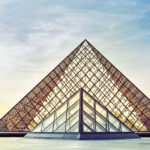 The Louvre: One of the world’s premiere museums was once a 14th Century palace of kings, built over eight centuries. You cannot possibly see the over 35,000 objects on display in one day. Focus on whatever interests you, and make sure you leave time for what is probably the best museum gift shop in the world. Try to visit on weekdays, and again purchase your ticket online to save time.
The Louvre: One of the world’s premiere museums was once a 14th Century palace of kings, built over eight centuries. You cannot possibly see the over 35,000 objects on display in one day. Focus on whatever interests you, and make sure you leave time for what is probably the best museum gift shop in the world. Try to visit on weekdays, and again purchase your ticket online to save time.
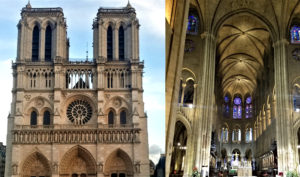 Notre Dame: On April 15, 2019, a fire devastated this world-famous cathedral. Restoration will take years. All those who saw Notre Dame before the fire know its grandeur, and grieve its destruction.
Notre Dame: On April 15, 2019, a fire devastated this world-famous cathedral. Restoration will take years. All those who saw Notre Dame before the fire know its grandeur, and grieve its destruction.
 Montmartre: This is one of the highest points in Paris, a looming hill within the city. It is an historically unique area, and home for centuries to many as artists: among them Monet, Renoir, Van Gogh and Picasso. The Basilica of the Sacré-Cœur is Montmartre’s premiere sight, and—until Notre Dame is restored—the foremost church in Paris. The basilica itself is impressive, and also offers wonderful views of Paris. Montmartre has the Moulin Rouge cabaret, with dinner shows which are best booked during the week and well in advance. There are a unique selection of cafes and shopping. This is one of the most walkable neighborhoods in Paris.
Montmartre: This is one of the highest points in Paris, a looming hill within the city. It is an historically unique area, and home for centuries to many as artists: among them Monet, Renoir, Van Gogh and Picasso. The Basilica of the Sacré-Cœur is Montmartre’s premiere sight, and—until Notre Dame is restored—the foremost church in Paris. The basilica itself is impressive, and also offers wonderful views of Paris. Montmartre has the Moulin Rouge cabaret, with dinner shows which are best booked during the week and well in advance. There are a unique selection of cafes and shopping. This is one of the most walkable neighborhoods in Paris.
 Pantheon: The Pantheon is in the Latin Quarter It was originally a church but now it is a mausoleum with the best panoramic views from the roof
Pantheon: The Pantheon is in the Latin Quarter It was originally a church but now it is a mausoleum with the best panoramic views from the roof
 Le Mariais: a unique neighborhood which was once the Jewish quarter, home to Victor Hugo, author of the Hunchback of Notre Dame and Les Misérables. His former home is now the Musee de Victor Hugo. The neighborhood is now full of trendy boutiques and cafés and great shopping for vintage items. It also boasts the Centre Pompidou, the Picasso Museum and the Musee des Arts Metiers, the oldest science museum in Europe. It is best experienced on foot. The Place des Vosges is one of the most memorable squares in Paris. The whole district has a lot of Medieval charm.
Le Mariais: a unique neighborhood which was once the Jewish quarter, home to Victor Hugo, author of the Hunchback of Notre Dame and Les Misérables. His former home is now the Musee de Victor Hugo. The neighborhood is now full of trendy boutiques and cafés and great shopping for vintage items. It also boasts the Centre Pompidou, the Picasso Museum and the Musee des Arts Metiers, the oldest science museum in Europe. It is best experienced on foot. The Place des Vosges is one of the most memorable squares in Paris. The whole district has a lot of Medieval charm.
 Opera: great stop for a look at the opera building and for shopping at Printemps Haussmann and Galeries Lafayette Haussmann, two of the best department stores in Paris
Opera: great stop for a look at the opera building and for shopping at Printemps Haussmann and Galeries Lafayette Haussmann, two of the best department stores in Paris
Tuileries Gardens: Beautiful public garden located between the Louvre and Place de Concorde, which also connects both the Musee de Orsay (French Impressionist art) and the Jeu de Paume (modern and postmodern photography). Both museums feature impressive art collections. This garden is the perfect place to relax between museums visits.
 Chateau de Versailles: Thirty minutes by train outside Paris is Versailles, the most glamorous grand palace in France, with spectacular gardens. It has been a world heritage site for more than 30 years. It is one of the very best examples of French 17th Century architecture, and has interiors adorned by a succession of kings until the French Revolution. Louis the 14th, the Sun King, created references throughout the palace to Apollo the sun god. During his 72-year reign, many of the most significant additions and designs were made to the palace. Hall of Mirrors, The Royal Opera, the royal apartments are the most interesting. There is also small, rustic, storybook hamlet created especially for Marie Antoinette to get away from royal life.
Chateau de Versailles: Thirty minutes by train outside Paris is Versailles, the most glamorous grand palace in France, with spectacular gardens. It has been a world heritage site for more than 30 years. It is one of the very best examples of French 17th Century architecture, and has interiors adorned by a succession of kings until the French Revolution. Louis the 14th, the Sun King, created references throughout the palace to Apollo the sun god. During his 72-year reign, many of the most significant additions and designs were made to the palace. Hall of Mirrors, The Royal Opera, the royal apartments are the most interesting. There is also small, rustic, storybook hamlet created especially for Marie Antoinette to get away from royal life.
Well worth the train ride out of town. Again, go during the week and get advanced online tickets to avoid the wait.
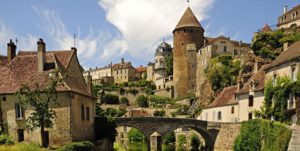 Semur-en-Auxois
Semur-en-Auxois
Pick up a car on the way out of Paris and drive toward Burgundy. You will be passing many delightful villages and vineyards including Chateau Nuf de Pape. I chose Semur-en-Auxois as a base for exploring Burgundy. It is a lovely medieval town located on the banks of the Armanon. I stayed in a beautiful cottage right on the river. See a room with a view. We were there for Armistice Day (November 11, Veterans Day in the United States), and a number of sites were closed, but staying in and just enjoying the ambiance in this medieval town was magical.
Burgundy
This district has an enormous amount of history. Today, it is known mainly for wine villages such as Chablis and Nuits. St. Georges. It is famous for Burgundy, Pinot Noirs, Chardonnays, Beaujolais and Chablis wines. The capital of Burgundy, Dijon, is most known for its unique mustard fame.
 Burgundy offers many historical sites to visit. The Basilica of Vezeley, the Abbey of Cluny (founded in 910 and dedicated to Saint Peter) and the Fontenay Abbey, a UNESCO World Heritage site believed the oldest preserved Cistercian abbey in the world.
Burgundy offers many historical sites to visit. The Basilica of Vezeley, the Abbey of Cluny (founded in 910 and dedicated to Saint Peter) and the Fontenay Abbey, a UNESCO World Heritage site believed the oldest preserved Cistercian abbey in the world.
Beaune is a beautiful and historic village. Its most memorable sites are the medieval Hospices de Beaune, known for its fine tile roof, and the Hotel Dieu.
 I stopped in the grocery store on the way back to our rental, and was blown away by the wine section in the store, and by the extremely low wine prices. I bought enough wine to enjoy until we reached Italy. This is a great region for both wine and food. Got back to the cozy home, which had a welcoming fireplace in the kitchen and cooked a simple but delightful dinner. We ate on a rustic table with the fire burning and the window opened to see the river meandering by—this rustic village in Burgundy could not have been more romantic!
I stopped in the grocery store on the way back to our rental, and was blown away by the wine section in the store, and by the extremely low wine prices. I bought enough wine to enjoy until we reached Italy. This is a great region for both wine and food. Got back to the cozy home, which had a welcoming fireplace in the kitchen and cooked a simple but delightful dinner. We ate on a rustic table with the fire burning and the window opened to see the river meandering by—this rustic village in Burgundy could not have been more romantic!
Lucerne
 The road from Beaune to Lucene is direct, on major highways and takes about four hours. We chose to stay in the old town, since we were only in town for the night. The old town is a tranquil part of Lucerne full of historic sites. The Hotel les Balances has great views and balconies, and was right on the river Reuss. We had a view of the iconic Chapel Bridge and the Jesuit Church. The old town has plenty of restaurants and shopping but be prepared for higher prices than in most larger cities in the US.
The road from Beaune to Lucene is direct, on major highways and takes about four hours. We chose to stay in the old town, since we were only in town for the night. The old town is a tranquil part of Lucerne full of historic sites. The Hotel les Balances has great views and balconies, and was right on the river Reuss. We had a view of the iconic Chapel Bridge and the Jesuit Church. The old town has plenty of restaurants and shopping but be prepared for higher prices than in most larger cities in the US.
The drive through the Gottard region with the snow-tipped Alps in the background was idyllic. But if you are at all claustrophobic (like I am), be prepared for the 10½ mile Gottard Road tunnel, a marvelous achievement of engineering. It has two lanes running is opposite directions. There are semi-trucks running in both directions, so it was a bit of a nail-biter, but the tunnel is well-lit and the road is in good condition. On the whole, I found the driving habits of the Swiss to be more conservative and courteous than many other European drivers.
Lake Como
 So many lakes and so little time. Which lake to choose? My favorite is Lake Como, located in the lush Lombardy region of Italy. It has been a popular destination since early Roman Times. Today, it is an upscale resort area, known for its spectacular scenery set against backdrop
So many lakes and so little time. Which lake to choose? My favorite is Lake Como, located in the lush Lombardy region of Italy. It has been a popular destination since early Roman Times. Today, it is an upscale resort area, known for its spectacular scenery set against backdrop  of the foothills beneath the snowcapped Alps. Driving to the different cities along the lake is possible, but the ferry services are convenient, simple and fairly priced. “Lake-hopping” on the ferries mostly without the car also provides spectacular views and is very convenient.
of the foothills beneath the snowcapped Alps. Driving to the different cities along the lake is possible, but the ferry services are convenient, simple and fairly priced. “Lake-hopping” on the ferries mostly without the car also provides spectacular views and is very convenient.
Leaving the ferry stations, you can walk through the picturesque villages, and see the graceful lakeside villas dotting the mountainside. The waterfront areas offer great shopping and cafes in a historic setting. The car ferry or “Traghetto” runs between the ports of Bellagio, Varenna, Cadenabbia and Menaggio. The schedule is  generally hourly, and the ride is between 10 to 15 minutes point to point. I drove around the lake and took the ferry. Both were a great deal of fun and interesting, though going by car requires finding a parking spot.
generally hourly, and the ride is between 10 to 15 minutes point to point. I drove around the lake and took the ferry. Both were a great deal of fun and interesting, though going by car requires finding a parking spot.
 I stayed in Varenna because it gives arguably the best view of Lake Como, has one of the best maintained medieval town centers on the lake, and is centrally located for visiting villages on the Lake. It is very laid back and relaxing. I picked a beautiful villa overlooking the water. See a room with a view. The villa borders “lover’s walk”: a scenic path that runs from the ferry station, and runs along the lake to the historic center. In the center you will find two churches that are well-worth a walk-through: San Giovanni Battista, of the 10th and 11th Centuries, and San Giorgio, built over an ancient temple.
I stayed in Varenna because it gives arguably the best view of Lake Como, has one of the best maintained medieval town centers on the lake, and is centrally located for visiting villages on the Lake. It is very laid back and relaxing. I picked a beautiful villa overlooking the water. See a room with a view. The villa borders “lover’s walk”: a scenic path that runs from the ferry station, and runs along the lake to the historic center. In the center you will find two churches that are well-worth a walk-through: San Giovanni Battista, of the 10th and 11th Centuries, and San Giorgio, built over an ancient temple.
The other town I really enjoyed close by was Bellagio, known as “the pearl of the lake” This village is full of Old-World charm and opulence. It is loaded with five-star hotels and delectable restaurants. Many of the old streets are narrow, and rise directly from the waterfront. There are other lakes to explore if you have time: Lake Garda, Lake Maggiore and Lake Iseo. Another great day trip from Varenna is Milan.
Milan
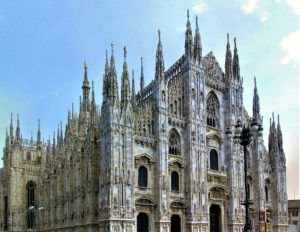 You cannot avoid the fashion aspect of Milan, a city of finance and fashion. The Golden Quadrilateral is very exclusive shopping district, with amazing window displays and penthouses built above them with rooftop gardens. You may not be inclined, or be able, to buy, but it is a good area to walk around and enjoy the people and the sights.
You cannot avoid the fashion aspect of Milan, a city of finance and fashion. The Golden Quadrilateral is very exclusive shopping district, with amazing window displays and penthouses built above them with rooftop gardens. You may not be inclined, or be able, to buy, but it is a good area to walk around and enjoy the people and the sights.
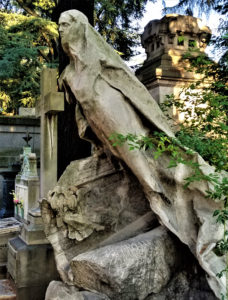 The Duomo, is the 4th largest cathedral in Europe and boasts a highly ornate gothic style. It was a seemingly endless project which stretched between 1386 until 1810. There are more statues in this building than any other in the world. Those who make the climb to the roof top are rewarded by views of the spires, statuary, and panoramas of Milan. The Last Supper, one of Leonardo da Vinci’s masterpieces, is in the Convent of Santa Maria delle Grazie. Getting your tickets well ahead of time online is an absolute must, and the ticket needs to be coordinated with other gallery visits.
The Duomo, is the 4th largest cathedral in Europe and boasts a highly ornate gothic style. It was a seemingly endless project which stretched between 1386 until 1810. There are more statues in this building than any other in the world. Those who make the climb to the roof top are rewarded by views of the spires, statuary, and panoramas of Milan. The Last Supper, one of Leonardo da Vinci’s masterpieces, is in the Convent of Santa Maria delle Grazie. Getting your tickets well ahead of time online is an absolute must, and the ticket needs to be coordinated with other gallery visits.
Another unique place in Milan is Monumental Cemetery, the most elaborate burial ground I have ever visited, densely packed with amazing monuments from the 19th and 20th Centuries. It is an, emotional and dramatic look at monuments made for the departed. Maybe an unusual choice for a sightseeing stop (though visiting old cemeteries in Europe is always exciting), but it is a fascinating look at funeral art and it is a pleasant oasis of tranquility in chaos of a large city.
Florence
 The trip from Lake Como to Florence is about a five-hour drive on major highways. If you get an early start and are feeling adventurous, stop in Bologna for lunch in Piazza Maggiore in the old town. There is a parking garage near the square called Garage Piazza Maggiore on Piazza Galileo 5. Parking there is around 6 euros per hour, rather high for Italy. You may have time for a quick lunch and/or take a brief look around. After lunch in Bologna, it is about two more hours drive to Florence. Didn’t get that early start—never fear, for there are plenty of roadside stops along the highway as you enjoy the scenic Tuscan countryside.
The trip from Lake Como to Florence is about a five-hour drive on major highways. If you get an early start and are feeling adventurous, stop in Bologna for lunch in Piazza Maggiore in the old town. There is a parking garage near the square called Garage Piazza Maggiore on Piazza Galileo 5. Parking there is around 6 euros per hour, rather high for Italy. You may have time for a quick lunch and/or take a brief look around. After lunch in Bologna, it is about two more hours drive to Florence. Didn’t get that early start—never fear, for there are plenty of roadside stops along the highway as you enjoy the scenic Tuscan countryside.
I have been to Florence a number of times and each time drove and parked in Piazzale Michelangelo, which is on a crest above the old town, and across the Arno River from it. You can walk down into the old town from there and enjoy fine views on the way. Sunsets over the city are particularly beautiful from here.
Taxis are available at the Piazzale. I usually walk down to the city, and for the return—after a day of sightseeing, and carrying whatever I have bought–take a cab back to my car.
There are other parking lots sprinkled on streets in town near hotels or near vacation rentals. It would be helpful to find out from the place where you stay those nearest you. They peppered around the old town and often not well marked.
The last time I was in Florence I stayed in the old town in an apartment with an elevator. It was the penthouse apartment, and it had fine views from all of the windows. When you rent an apartment in the old town, there is a good chance you will not get an elevator and if you want the view and to stay on the highest floor this can be murderous for taking luggage up and down the stairs. Often, the host will provide assistance, but often not (even if they tell you they will in advance). I would definitely pay a bit extra for an elevator because when you are out all day sightseeing it is tough to return back to your rental with groceries or souvenirs and have to take many flights of stairs. See a room with a view.
Florence is of course one of the jewels of Italy, and also a dynamic city, rich in extraordinary art and architecture. It is the birthplace of the Italian Renaissance. The entire city is a UNESCO World Heritage Site. The old town is a no traffic zone, and so it is pleasantly walkable. Most of the most important sites are within 15 minutes of one another.
My favorite sites are:
 Cathedral of Santa Maria de Fiore: The completion of its dome by Brunelleschi was one of the most significant architectural feats of the Renaissance It remains the largest brick dome ever constructed and influenced many others. A climb to the top of the dome will give you some of the best views in Florence, but—as with all popular sites—be sure to reserve you ticket online in advance. The Cathedral Museum contains many of the original exterior pieces brought inside for protection.
Cathedral of Santa Maria de Fiore: The completion of its dome by Brunelleschi was one of the most significant architectural feats of the Renaissance It remains the largest brick dome ever constructed and influenced many others. A climb to the top of the dome will give you some of the best views in Florence, but—as with all popular sites—be sure to reserve you ticket online in advance. The Cathedral Museum contains many of the original exterior pieces brought inside for protection.
 The Baptistry is across from the Cathedral The bronze gates were considered revolutionary in their day for their realism. The ones outside are reproductions of the originals contained in the Cathedral museum close by. The 13th Century Byzantine style mosaic on the interior is luminous.
The Baptistry is across from the Cathedral The bronze gates were considered revolutionary in their day for their realism. The ones outside are reproductions of the originals contained in the Cathedral museum close by. The 13th Century Byzantine style mosaic on the interior is luminous.
 The Accademia Museum houses the iconic statue of Michelangelo’s David, a true masterpiece in marble. The statue stands14 feet. His huge right hand, out of proportion with the rest of his body, is said to represent a hand blessed by God to slay Goliath. To reach David, the visitor passes a gauntlet of Michelangelo’s unfinished statues that are lined up. These are especially interesting as they show artistic works in progress, and the figures seemed to be literally emerging from the stone. Over the centuries the unfinished works have been interpreted in many different ways most recently “the eternal struggle of human beings to free themselves from their material trappings.”
The Accademia Museum houses the iconic statue of Michelangelo’s David, a true masterpiece in marble. The statue stands14 feet. His huge right hand, out of proportion with the rest of his body, is said to represent a hand blessed by God to slay Goliath. To reach David, the visitor passes a gauntlet of Michelangelo’s unfinished statues that are lined up. These are especially interesting as they show artistic works in progress, and the figures seemed to be literally emerging from the stone. Over the centuries the unfinished works have been interpreted in many different ways most recently “the eternal struggle of human beings to free themselves from their material trappings.”
The Uffizi Gallery is one of the most visited museums in the world (again, get tickets ahead of time). Botticelli’s Birth of Venus and Primavera make the trip worthwhile for me. With them are works by the Renaissance masters: Leonardo, Michelangelo Raphael and Caravaggio. Seeing all the treasures in a single day, may overwhelm you. Do a bit of research beforehand to decide what you want to see.
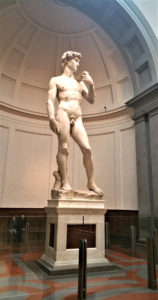 Piazza della Signoria has been the center of political influence since the 14th Century, and is still a busy hub of activity. Even so, ample cafes line it and offer greats places to sit for a drink or lunch. The Piazza includes the Palazzo Vecchio or Old Palace, the town hall of Florence. It was once the palace of the Medici’s. It is the site of the 1497 Bonfire of the Vanities (when objects tempting one to sin-mirrors, cosmetics, fine dresses, playing cards, books, art—were burned by Dominican friars). It is also the original home of Michelangelo’s David. A reproduction of this piece is placed in its original position.
Piazza della Signoria has been the center of political influence since the 14th Century, and is still a busy hub of activity. Even so, ample cafes line it and offer greats places to sit for a drink or lunch. The Piazza includes the Palazzo Vecchio or Old Palace, the town hall of Florence. It was once the palace of the Medici’s. It is the site of the 1497 Bonfire of the Vanities (when objects tempting one to sin-mirrors, cosmetics, fine dresses, playing cards, books, art—were burned by Dominican friars). It is also the original home of Michelangelo’s David. A reproduction of this piece is placed in its original position.
The Basilica of Santa Croce is best known for the tombs of Michelangelo, Galileo, and Machiavelli, and a memorial to Dante. Because of his exile Dante was put to rest in Ravenna. This lovely church also boasts a superb set of frescos by Giotto.
San Lorenzo Market is a great spot for a quick lunch or to pick up a souvenir. The exterior portion of the market offers leather, clothing and accessories, while the indoor market has meat, fish, vegetables and a fruit market. Upstairs is full of excellent lunch choices. It is a distinctive Florentine market well worth your time.
The Pitti Palace, like the Palazzo Vecchio, is a former Medici palace. The Pitti is located in the Oltrarno section of Florence and has an even more remarkable interior. It is home to a to a silver museum, porcelain museum, modern art museum, a museum of clothing and fashion as well as having a Renaissance art museum. It is a palace that has something to interest everyone.
Tuscany
 There are a number of fine day trips out of Florence, wonderful scenic drives into the Tuscan countryside. Driving, rather than taking a train, allows you to indulge in the beauty of this unforgettable region with its rolling hills lined with cypress trees and vineyards.
There are a number of fine day trips out of Florence, wonderful scenic drives into the Tuscan countryside. Driving, rather than taking a train, allows you to indulge in the beauty of this unforgettable region with its rolling hills lined with cypress trees and vineyards.
One trip is to Lucca and Pisa. Pisa has iconic Leaning Tower, the Cathedral of Santa Maria Assunta and the Baptistry, all built in beautifully distinctive Romanesque design. Legend has it that Galileo conceived the “isochronism of the pendulum” (the basis for pendulum clocks, among other things) while watching a suspended chandelier swing in the Cathedral. He did, as other legends claim, study the laws of falling objects by dropping them from the Leaning Tower
Lucca
 Lucca is a multilayered historical city which has been around since before early Roman times. It completely surrounded by city walls dating back to the 16th -17th Century which give the town its peaceful grace. Woven in to its historic center is over one hundred churches of various architectural styles. It is in the valley of the Serchio river bounded by hills with the Apuane Alps to the north and west.
Lucca is a multilayered historical city which has been around since before early Roman times. It completely surrounded by city walls dating back to the 16th -17th Century which give the town its peaceful grace. Woven in to its historic center is over one hundred churches of various architectural styles. It is in the valley of the Serchio river bounded by hills with the Apuane Alps to the north and west.
San Gimignano
Other intriguing day  trips are to some of the hilltop towns in the Tuscan countryside. San Gimignano is a dream as it rises on the horizon with a skyline of fourteen medieval towers amid miles of vineyards and gently rolling hills. The town is encircled by 13th Century walls which are an adventurous hike. One of the most striking features
trips are to some of the hilltop towns in the Tuscan countryside. San Gimignano is a dream as it rises on the horizon with a skyline of fourteen medieval towers amid miles of vineyards and gently rolling hills. The town is encircled by 13th Century walls which are an adventurous hike. One of the most striking features  is its 12th Century Duomo with extraordinary frescos by a variety of artists. Perhaps chief among them is the Taddeo di Bartolo fresco Portrait of Hell, a graphic depiction of the devil and hell, an image right out of Dante’s Inferno. I stayed there for several days in November in an apartment on the square facing the duomo. There were minimal tourists at that time and the town looks otherworldly at twilight. It is a good base for exploring the Tuscan hill towns.
is its 12th Century Duomo with extraordinary frescos by a variety of artists. Perhaps chief among them is the Taddeo di Bartolo fresco Portrait of Hell, a graphic depiction of the devil and hell, an image right out of Dante’s Inferno. I stayed there for several days in November in an apartment on the square facing the duomo. There were minimal tourists at that time and the town looks otherworldly at twilight. It is a good base for exploring the Tuscan hill towns.
Siena
 Siena is perched over three hilltops and is bursting with gothic style. It is distinguished by its medieval brick architecture. Siena’s most recognizable building is the Pubblico Palace, on its famous central square, Piazza del Campo. Most important sites of Siena are within a 10 minute walk of the square. The Piazza, is the site of the twice annual horse race, Palio di Siena. Palio di Provenzano is held on July 2, and Palio dell’Assunta on August 16. On those days, the square is jammed, but otherwise, the many cafes on the square are fine places to just relaxing with a glass of wine or a bite to eat. Many locals flood the square to walk in the evening. The black and white duomo is a masterwork of Gothic style.
Siena is perched over three hilltops and is bursting with gothic style. It is distinguished by its medieval brick architecture. Siena’s most recognizable building is the Pubblico Palace, on its famous central square, Piazza del Campo. Most important sites of Siena are within a 10 minute walk of the square. The Piazza, is the site of the twice annual horse race, Palio di Siena. Palio di Provenzano is held on July 2, and Palio dell’Assunta on August 16. On those days, the square is jammed, but otherwise, the many cafes on the square are fine places to just relaxing with a glass of wine or a bite to eat. Many locals flood the square to walk in the evening. The black and white duomo is a masterwork of Gothic style.
Cinque Terre
The Cinque Terre villages (Monterosso al Mare, Vernazza, Corniglia, Manarola, and Riomaggiore) are dramatically perched along a six-mile section of the Italian Rivera. An excursion to the Cinque Terre from Florence is a long day trip. I would recommend taking the train, which is faster, with stops at the centers of each of the five villages. Driving will probably involve parking at some distance from the historical center, and a hike down and back. So, if your time is limited and you are not spending the night driving is more trouble than it is worth. There are beautiful hikes and great boat trips between the villages.
I have stayed in Manarola a few nights, and the drive is remarkably scenic above La Spezia. If you spend a night or two there, it is a worthwhile car journey to and through the most striking part of the Italian Rivera.
Assisi
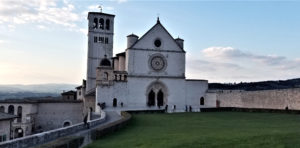 The drive from Florence to Rome is about 4 hours, and is scenic. It is my personal preference to make a side trip to Assisi (about a 2 1/2 hour drive) and stay a night or two in the old town on the hill above modern Assisi. For me Old Town Assisi, due to its association with Saint Francis, is the spiritual heart of Italy, and I visit every chance I get. As a prime site of religious pilgrimage, the town can be crowded during the day, but is an entirely different town when the sun goes down and day-tripping tourists depart. Even off-season Assisi can see many tourists during day, and there is a large industry established around selling Saint Francis souvenirs. as he is the patron saint of Assisi.
The drive from Florence to Rome is about 4 hours, and is scenic. It is my personal preference to make a side trip to Assisi (about a 2 1/2 hour drive) and stay a night or two in the old town on the hill above modern Assisi. For me Old Town Assisi, due to its association with Saint Francis, is the spiritual heart of Italy, and I visit every chance I get. As a prime site of religious pilgrimage, the town can be crowded during the day, but is an entirely different town when the sun goes down and day-tripping tourists depart. Even off-season Assisi can see many tourists during day, and there is a large industry established around selling Saint Francis souvenirs. as he is the patron saint of Assisi.
 It is also a must-see destination for anyone interested in art, architecture and religious history. For people on tight schedules a day trip will suffice on the road to Rome or a daytrip out of Rome. There is plenty of public parking at the top next to the old town during the off season and is pretty inexpensive.
It is also a must-see destination for anyone interested in art, architecture and religious history. For people on tight schedules a day trip will suffice on the road to Rome or a daytrip out of Rome. There is plenty of public parking at the top next to the old town during the off season and is pretty inexpensive.
As a young man, Giovanni di Pietro di Bernardone—who would become St. Francis—had a vision of God which changed his life. He renounced the luxury of the material world in to live amongst the poor. He encouraged a return to the basic teachings of Christ to love all in creation and established the Franciscan movement. The Basilica of Saint Mary of the Angels is at the base of the hill town of Assisi near the train station. It contains the Porziuncolas, the small chapel where Saint Francis allegedly spent most of his life and died. The grand Basilica of Saint Mary of the Angels was built around the very modest chapel during the 16th-17th Centuries.
 Atop the hill above Assisi and the Basilica is the medieval hill town. The view from below is framed by the rolling hills of Umbria, splashed with the silver green of the olive trees. It is splendid especially in the glow of sunset. The road to take to get to the old town rises in twists and turns and there are scenic panoramas at each bend looking down below. Large busses are always on these narrow roads during daylight hours, and motorists must exercise caution.
Atop the hill above Assisi and the Basilica is the medieval hill town. The view from below is framed by the rolling hills of Umbria, splashed with the silver green of the olive trees. It is splendid especially in the glow of sunset. The road to take to get to the old town rises in twists and turns and there are scenic panoramas at each bend looking down below. Large busses are always on these narrow roads during daylight hours, and motorists must exercise caution.
The old town itself is a medieval jewel, a UNESCO World Heritage site. The Basilica di San Francesco is the most visited monument in town. It is a spiritual and artistic shrine with some of the most memorable frescos in Italy. The most well-known frescos are those of Giotto. The Basilica has three parts. The lower level contains the tomb of Saint Francis, and above it is the lower and upper basilicas which are filled with wall to wall frescos and unique historical artifacts.
 There is also a modest church, San Damiano, within walking distance of the outskirts of the old town. It is a scenic 15-minute walk from the Basilica of St Clare through an olive grove. This church/ convent is a peaceful spot to stroll with its colorful floral courtyard. It is the place where St Francis was called by God to reinvigorate the Christian Church. A reproduction of the cross that is said to have spoken to him is in a room in the convent and the original is in the Basilica.
There is also a modest church, San Damiano, within walking distance of the outskirts of the old town. It is a scenic 15-minute walk from the Basilica of St Clare through an olive grove. This church/ convent is a peaceful spot to stroll with its colorful floral courtyard. It is the place where St Francis was called by God to reinvigorate the Christian Church. A reproduction of the cross that is said to have spoken to him is in a room in the convent and the original is in the Basilica.
The Basilica of St Clare is dedicated to the founder of the order of Clare’s, a monastic order for women, in the spirit of the male Franciscan order. Saint Clare and her followers spent their time at the Convent and Church of San Damiano. The basilica was built for her order and to honor her after her death. It contains her tomb and possessions. See sacred spaces.
That is a lot to see in one day but it is doable if you are just stopping by on your way to Rome. I recommend staying the night, both to ease the pace of visiting sights, and to see the different city that emerges after tourists leave. It is also a good base for exploring some of the beautiful hill towns in Umbria such as Gubbio, Spello or Todi. Which I will cover in a later post.
 The drive from Assisi to Rome is about 175 kilometers. There are a number of choices if you want to stop of for a quick bite for lunch with a little sightseeing. You could stop in Civita di Bagnoregio a ghost like town that seems to be floating in the air above the valley floor. I stopped for lunch in front of the town but did not cross the pedestrian bridge which is up uphill hike for 20 or 30 minutes. Standing in front of the bridge is a beautiful photo op and worth stopping for the view. It was November so most things were closed in this quiet village.
The drive from Assisi to Rome is about 175 kilometers. There are a number of choices if you want to stop of for a quick bite for lunch with a little sightseeing. You could stop in Civita di Bagnoregio a ghost like town that seems to be floating in the air above the valley floor. I stopped for lunch in front of the town but did not cross the pedestrian bridge which is up uphill hike for 20 or 30 minutes. Standing in front of the bridge is a beautiful photo op and worth stopping for the view. It was November so most things were closed in this quiet village.  Orvieto is another choice for lunch. It is about ninety minutes north of Rome and about forty-five minutes from Civita. It is located high up on a hill of volcanic stone and is surrounded by a defensive wall. It can be reached by the Orvieto Funicular which you can pick up in Orvieto Scalo below the old town. Lunch near the dazzling Orvieto Cathedral is a must. It is a spectacular 14th century Roman Catholic Cathedral dedicated to the Assumption of the Virgin Mary.
Orvieto is another choice for lunch. It is about ninety minutes north of Rome and about forty-five minutes from Civita. It is located high up on a hill of volcanic stone and is surrounded by a defensive wall. It can be reached by the Orvieto Funicular which you can pick up in Orvieto Scalo below the old town. Lunch near the dazzling Orvieto Cathedral is a must. It is a spectacular 14th century Roman Catholic Cathedral dedicated to the Assumption of the Virgin Mary.
Rome
On arriving in Rome—or any large metropolis—I turn in the car, and use public transportation or taxis. Learning a city’s public transport at first can be daunting, but take the plunge and you will be surprised how easy most of the systems are to use.
In a city the size of Rome it is important to be able to get around and see things in an efficient manner and I always recommend taking one of the double-decker hop-on-&-off city tours. Like many cities of its size, Rome boasts multiple, intersecting tours. They take you to and near almost every important site. From the upper deck you can see the buildings and monuments from a different prospective. To some, such busses are “too touristy,” but I have found it an efficient use of time. There are other trips out of Rome by car that I will mention in later posts.
If I could only visit one city in Italy for the rest of my life it would be Rome. It is an intoxicating fusion of art, architecture and history. It is one of the most romantic and hypnotic cities in Europe, full of a vibrant la dolce vita.
 The Roman Republic and Empire lasted about 1,000 years (roughly from 500 BC to 500 AD; the Western Roman Empire, centered on Constantinople—now Istanbul—lasted until 1453). It developed its grandeur from Greece, and passed it on to the Catholic Church. Each new reign built its city over what it inherited from the past, and created some of the world’s most unique buildings. As Rome evolved, roofs of the old became foundations of the new. The most ancient structures lie far below current city. There are fascinating tours of Rome’s hidden underground cities.
The Roman Republic and Empire lasted about 1,000 years (roughly from 500 BC to 500 AD; the Western Roman Empire, centered on Constantinople—now Istanbul—lasted until 1453). It developed its grandeur from Greece, and passed it on to the Catholic Church. Each new reign built its city over what it inherited from the past, and created some of the world’s most unique buildings. As Rome evolved, roofs of the old became foundations of the new. The most ancient structures lie far below current city. There are fascinating tours of Rome’s hidden underground cities.
Rome is the birthplace of Baroque Architecture, and a rare place where you can see masterworks of art on the backstreets in small basilicas and churches. Works of such greats as Caravaggio, Raphael, and Bernini can be quietly contemplated in the sacred spots they were designed for without the huge museum crowds.
Some of my favorite highlights are of Rome are:
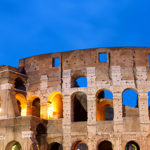 The Colosseum, ruins of an iconic architectural wonder, is believed to have been opened to the public in 80 AD. It is actually two theaters facing one another. In early times it could hold nearly 50,000 people. It is one of the few theaters to combine Doric, Ionic and Corinthian columns. Even in the low season, I recommend making a reservation online so you do not waste time in long lines.
The Colosseum, ruins of an iconic architectural wonder, is believed to have been opened to the public in 80 AD. It is actually two theaters facing one another. In early times it could hold nearly 50,000 people. It is one of the few theaters to combine Doric, Ionic and Corinthian columns. Even in the low season, I recommend making a reservation online so you do not waste time in long lines.
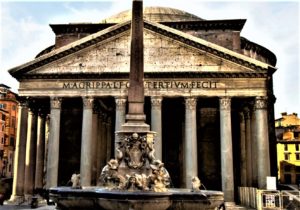 The Pantheon, a former Roman temple to the Gods and the tomb of kings, and now a church, is the best-preserved monument of ancient Rome. There are no reservations for this monument, but visiting early in the day is recommended to avoid possible crowds.
The Pantheon, a former Roman temple to the Gods and the tomb of kings, and now a church, is the best-preserved monument of ancient Rome. There are no reservations for this monument, but visiting early in the day is recommended to avoid possible crowds.
 Vatican City (The Vatican), a sovereign state completely surrounded by Rome, is comprised of St. Peter’s Basilica, museums, offices for conducting church business, and of course endless souvenir shops. In the 4th Century, Emperor Constantine had the original basilica built over the tomb of St Peter during his reign. Then in early 17th Century the world’s largest church was built over the site. Bernini’s alter piece captivates a crowd as well as Michelangelo’s Pieta. Make sure if you are able to climb steps you climb to the top of St Peters dome for the best city panoramas. It is best to go very early (~8 am) to avoid crowds even in the low season. The Sistine Chapel, which encloses Michelangelo’s ceiling masterpiece of scenes from the book of Genesis and the most iconic The Creation of Adam, is exquisite. The Last Judgment on the alter wall is elaborate and unforgettable. The other interior walls are decorated with frescos by many Florentine Renaissance masters.
Vatican City (The Vatican), a sovereign state completely surrounded by Rome, is comprised of St. Peter’s Basilica, museums, offices for conducting church business, and of course endless souvenir shops. In the 4th Century, Emperor Constantine had the original basilica built over the tomb of St Peter during his reign. Then in early 17th Century the world’s largest church was built over the site. Bernini’s alter piece captivates a crowd as well as Michelangelo’s Pieta. Make sure if you are able to climb steps you climb to the top of St Peters dome for the best city panoramas. It is best to go very early (~8 am) to avoid crowds even in the low season. The Sistine Chapel, which encloses Michelangelo’s ceiling masterpiece of scenes from the book of Genesis and the most iconic The Creation of Adam, is exquisite. The Last Judgment on the alter wall is elaborate and unforgettable. The other interior walls are decorated with frescos by many Florentine Renaissance masters.
 The Roman Forum has been a gathering place for social, political and religious activities since Roman republic was founded about 500 BC. It was the site of many of the city’s most magnificent temples and monuments. Enjoy an early morning stroll through this historical wonderland.
The Roman Forum has been a gathering place for social, political and religious activities since Roman republic was founded about 500 BC. It was the site of many of the city’s most magnificent temples and monuments. Enjoy an early morning stroll through this historical wonderland.
 The Spanish Steps leading to the Trinita dei Monti church have been in the scenes of many movies. It is a great gathering spot and relaxing area for enjoying the atmosphere and beautiful views. The Keats-Shelley house, where Keats spent the last years of his life, is located next to the steps. Some of the Keats’s memorabilia, letters and manuscripts are housed there, as are items from other writers from the English Romantic movement. At the bottom of the steps, near the Piazza di Spagna, is a vast area for shopping and dining.
The Spanish Steps leading to the Trinita dei Monti church have been in the scenes of many movies. It is a great gathering spot and relaxing area for enjoying the atmosphere and beautiful views. The Keats-Shelley house, where Keats spent the last years of his life, is located next to the steps. Some of the Keats’s memorabilia, letters and manuscripts are housed there, as are items from other writers from the English Romantic movement. At the bottom of the steps, near the Piazza di Spagna, is a vast area for shopping and dining.
Borghese Park has been called Rome’s Central Park. It is full of green spaces and is romantic spot for a picnic lunch. It is best known for the Villa Borghese, a Baroque Masterpiece, packed with art work from Raphael, Titian, Rubens and Bernini, beautifully displayed. There is also a Modern Art Museum, Botanical Garden and Zoo and lake in the park.
 Piazza Navona, is one of the most spectacular squares in Centro Storico (“historic center,” sometimes called the heart of Rome), is a brilliant place to relax and have a meal, though it may be more expensive because of the venue. It is also crowded with vendors hawking wares, street artists, and tourists. The draw is Navonna’s is rich in baroque palaces and the square contains one of Bernini’s masterful fountains. It a great stop for a photo op and soak up the exuberant Roman street life. I found a lovely penthouse floor apartment around the corner from piazza. It was a perfect place to stay and the building was mostly full of area residents. (See a room with a view).
Piazza Navona, is one of the most spectacular squares in Centro Storico (“historic center,” sometimes called the heart of Rome), is a brilliant place to relax and have a meal, though it may be more expensive because of the venue. It is also crowded with vendors hawking wares, street artists, and tourists. The draw is Navonna’s is rich in baroque palaces and the square contains one of Bernini’s masterful fountains. It a great stop for a photo op and soak up the exuberant Roman street life. I found a lovely penthouse floor apartment around the corner from piazza. It was a perfect place to stay and the building was mostly full of area residents. (See a room with a view).
 Trastevere is a peaceful medieval neighborhood across the Tiber. It is a short stroll across Ponte Sisto, a stone footbridge. On my most recent trip to Rome I nearly stayed there because it had more of a quiet neighborhood feel and it truly has its own unique Roman vibe. It is a community best explored on foot. The Piazza di Santa Maria is the heart of this vibrant quarter. The square is dominated by the 12th Century Basilica di Santa Maria, one of the oldest churches in Rome. It contains glittering gold mosaic, and a nave supported by columns plundered from the Baths of Caracalla. Outside this piazza are a labyrinth of narrow streets with centuries-old squares filled with Medieval Architecture, monuments and great restaurants.
Trastevere is a peaceful medieval neighborhood across the Tiber. It is a short stroll across Ponte Sisto, a stone footbridge. On my most recent trip to Rome I nearly stayed there because it had more of a quiet neighborhood feel and it truly has its own unique Roman vibe. It is a community best explored on foot. The Piazza di Santa Maria is the heart of this vibrant quarter. The square is dominated by the 12th Century Basilica di Santa Maria, one of the oldest churches in Rome. It contains glittering gold mosaic, and a nave supported by columns plundered from the Baths of Caracalla. Outside this piazza are a labyrinth of narrow streets with centuries-old squares filled with Medieval Architecture, monuments and great restaurants.
 Some Churches Not To Be Missed: Small backstreet churches and basilicas are all over Rome and are loaded with hidden treasures. They are usually free to enter and less crowded than museums. Though the exteriors of these churches may look nondescript, their wonder is in the interior art and sculpture. The Santa Maria Sopra Minerva Basilica, Rome’s only Gothic church, contains a unique sculpture by Michelangelo, Cristo Risorto. The body minus the head (the head is interred elsewhere) of Catherine of Siena lies below the alter and two Medici Popes are also entombed there. The Church of Santa Maria del Popolo (“Saint Mary of the People”) is a small church with a Renaissance and Baroque interior. Its treasures include two paintings by Caravaggio, and a chapel built and decorated by Raphael. Bernini was involved in its architectural design. Legend has it that this church was built to exorcise the emperor Nero’s ghost, which allegedly haunted his grave (once located near this spot) in earlier centuries. The Church of St Peter in Chains was built in the 5th Century to house the relic of the chains that bound St Peter while imprisoned in Rome then later in Jerusalem. The most spectacular site in the Basilica of San Pietro in Vincoli is Michelangelo’s sculpture of Moses which is colossal. The Church of Santa Maria della Vittoria is best known for the masterpiece of Gian Lorenzo Bernini, the Ecstasy of Saint Teresa.
Some Churches Not To Be Missed: Small backstreet churches and basilicas are all over Rome and are loaded with hidden treasures. They are usually free to enter and less crowded than museums. Though the exteriors of these churches may look nondescript, their wonder is in the interior art and sculpture. The Santa Maria Sopra Minerva Basilica, Rome’s only Gothic church, contains a unique sculpture by Michelangelo, Cristo Risorto. The body minus the head (the head is interred elsewhere) of Catherine of Siena lies below the alter and two Medici Popes are also entombed there. The Church of Santa Maria del Popolo (“Saint Mary of the People”) is a small church with a Renaissance and Baroque interior. Its treasures include two paintings by Caravaggio, and a chapel built and decorated by Raphael. Bernini was involved in its architectural design. Legend has it that this church was built to exorcise the emperor Nero’s ghost, which allegedly haunted his grave (once located near this spot) in earlier centuries. The Church of St Peter in Chains was built in the 5th Century to house the relic of the chains that bound St Peter while imprisoned in Rome then later in Jerusalem. The most spectacular site in the Basilica of San Pietro in Vincoli is Michelangelo’s sculpture of Moses which is colossal. The Church of Santa Maria della Vittoria is best known for the masterpiece of Gian Lorenzo Bernini, the Ecstasy of Saint Teresa.
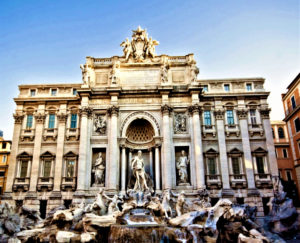 These are just a few of the small churches with hidden treasures. Last but not least an after-dark trip to the Trevi Fountain is a must. It is the largest and most beautiful fountain in Rome. Legend says throwing a coin into the fountain means that you will return. I throw in a coin every time I go.
These are just a few of the small churches with hidden treasures. Last but not least an after-dark trip to the Trevi Fountain is a must. It is the largest and most beautiful fountain in Rome. Legend says throwing a coin into the fountain means that you will return. I throw in a coin every time I go.



Leave a Comment